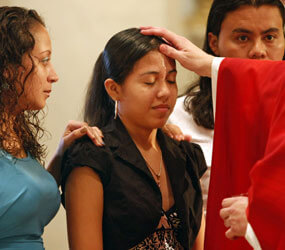WASHINGTON – Statistically, there are few surprises in the 2009 Official Catholic Directory.
The number of patients served in Catholic hospitals and the number of clients assisted by Catholic charitable agencies went up. Fewer baptisms, first Communions, confirmations and marriages were performed in Catholic churches last year. The number of Catholic parishes and elementary schools in the U.S. continues to decline.
But here and there, there are signs of hope in the statistical summary that is designed to present a snapshot of what the U.S. Catholic Church looked like on Jan. 1, 2009.
The totals for priests, permanent deacons and diocesan seminarians each experienced a small increase in the 2009 book. There were more students in Catholic colleges and universities; in private, Catholic-run high schools and elementary schools; and in high school religious education programs.
And at 68.1 million, an increase of nearly 1 million over the 2008 directory, Catholics continue to make up 22 percent of the U.S. population.
The more than 2,100-page Official Catholic Directory, also known as the Kenedy directory after its New Jersey publishers’ imprint, P.J. Kenedy and Sons, is due out June 17. Catholic News Service obtained an advance copy of the statistical summary compiled from annual reports provided by the nation’s 209 dioceses and archdioceses.
The book lists all ordained U.S. Catholic priests, parishes, missions, schools, hospitals and other institutions. It also gives statistical data on the church by diocese and nationally. Its national figures include data from Puerto Rico, a U.S. commonwealth, and U.S. territories overseas such as the U.S. Virgin Islands, American Samoa and Guam.
The latest edition also features special reports on Catholic higher education in the U.S., the year of St. Paul celebration, a look at the sainthood process and the year in review.
The 2009 Kenedy directory shows a total U.S. Catholic population of 68,115,001, compared to 67,117,016 the year before. But because the U.S. population rose from 305.2 million to 307.6 million during that time, the percentage of Catholics in the U.S. population was steady at 22 percent.
In a time of economic downturn, it was not surprising to see a rise of 1.2 million in the number of people assisted by Catholic charitable agencies, from just under 26 million in the 2008 directory to 27.2 million the next year.
The number of patients served in Catholic hospitals went up nearly 1.5 million, from 83.8 million last year to 85.3 million in 2009. The 562 Catholic hospitals in the 2009 tally were five more than the 557 counted in the 2008 directory, but the number of Catholic-run health care centers – including ancillary care systems, medical centers, sanatoriums and hospices – declined from 417 to 373. Another 6.7 million patients were served in those centers, according to the 2009 book, a drop of more than half a million from the 7.3 million patients served the previous year.
In key sacramental moments, according to the directory:
– There were 191,265 church-recognized marriages in the year ending Jan. 1, 2009, more than 5,000 fewer than the year before.
– Confirmations numbered more than 622,000, down about 8,500 from the previous year.
– First Communions numbered nearly 822,000, a drop of about 1,300.
– Infant baptisms totaled more than 887,000, down by almost 16,000.
– Adult baptisms and receptions into full communion totaled more than 124,000, a decline of more than 12,000 from the previous year.
Even though 91 new parishes were opened in 2008, an increase of 34 over the year before, there was a net loss of 216 parishes because of closings or mergers, as the total decreased from 18,890 to 18,674.
The total number of priests in U.S. dioceses and religious orders was 41,489, an increase of 83 over the previous year. The increase was 89 for religious-order priests, offsetting a decrease of six for diocesan priests.
Permanent deacons went from 16,408 at the beginning of 2008 to 16,935 the next year, an increase of 527. The number of diocesan seminarians went up by 26 to 3,274, but the number studying for the religious-order priesthood decreased by 82 to 1,699.
The number of brothers dropped by 135 to 4,905 at the beginning of 2009, while the number of sisters was down more than 2,300 to 60,715.
There was a mixed picture for Catholic education in the United States.
At the college level, there were 795,823 students in Catholic-run schools, up more than 1,500 from the year before. Also showing increases were the student bodies at private Catholic high schools – up more than 6,500 to 312,727 – and private elementary schools, which went up more than 1,600 to 90,501.
But the student populations at diocesan- and parish-run Catholic schools continued to decline. There were 361,653 students at those high schools, a drop of nearly 13,000, while the number attending diocesan or parish elementary schools was 1,518,886, a decrease of more than 57,000.
The number of diocesan and parish elementary schools fell by nearly 500 to 5,772, while the number of private Catholic elementary schools increased by five to 361. Diocesan and parish high schools were down by 18 to 751, while private Catholic high schools increased by seven to 590.
Enrollment by public school students in high school religious education classes grew by more than 33,000 to more than 722,000, but the number of elementary school students attending such classes fell by more than 64,000 to under 3.1 million.
The faculty at Catholic schools was overwhelmingly made up of lay teachers, at nearly 168,000. There were 1,569 priests, 27 scholastics, 916 brothers and 5,169 sisters teaching in Catholic schools at the start of 2009.


